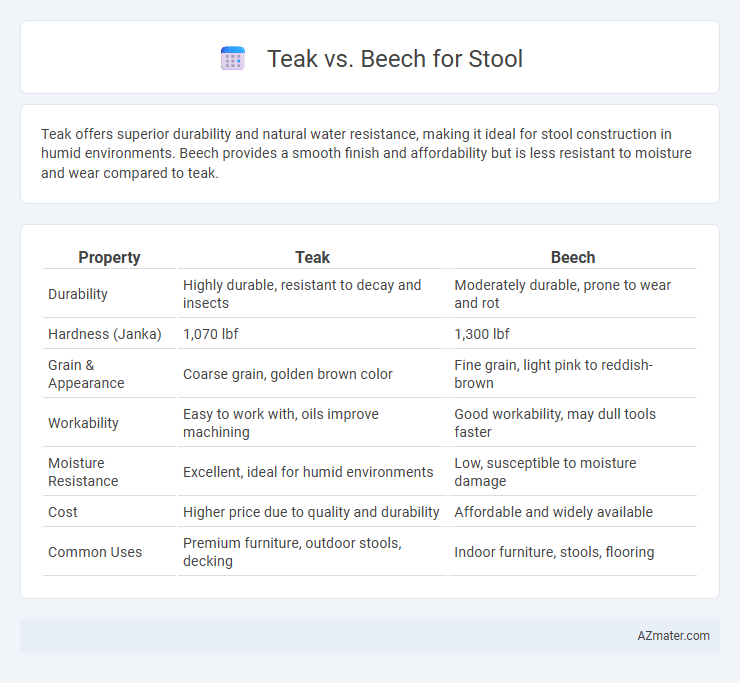Teak offers superior durability and natural water resistance, making it ideal for stool construction in humid environments. Beech provides a smooth finish and affordability but is less resistant to moisture and wear compared to teak.
Table of Comparison
| Property | Teak | Beech |
|---|---|---|
| Durability | Highly durable, resistant to decay and insects | Moderately durable, prone to wear and rot |
| Hardness (Janka) | 1,070 lbf | 1,300 lbf |
| Grain & Appearance | Coarse grain, golden brown color | Fine grain, light pink to reddish-brown |
| Workability | Easy to work with, oils improve machining | Good workability, may dull tools faster |
| Moisture Resistance | Excellent, ideal for humid environments | Low, susceptible to moisture damage |
| Cost | Higher price due to quality and durability | Affordable and widely available |
| Common Uses | Premium furniture, outdoor stools, decking | Indoor furniture, stools, flooring |
Introduction: Teak vs Beech for Stool Construction
Teak offers exceptional durability and natural resistance to moisture and insects, making it ideal for stool construction in humid environments. Beech features a fine grain and uniform texture, providing a smooth finish and strong structural integrity for indoor stools. Choosing between teak and beech depends on factors such as intended use, environmental exposure, and desired aesthetic qualities.
Wood Characteristics: Teak and Beech Overview
Teak wood features natural oils and dense grain, offering exceptional durability, water resistance, and a rich golden-brown color ideal for stools used in humid or outdoor environments. Beech wood is a pale, fine-grained hardwood known for its smooth texture, ease of shaping, and affordability, making it suitable for indoor stools requiring a light, uniform appearance. Both woods balance strength and aesthetic qualities, but teak excels in longevity and weather resistance while beech emphasizes cost-effective versatility and smooth finishes.
Durability and Longevity Comparison
Teak wood offers exceptional durability and longevity for stools due to its high oil content and natural resistance to moisture, pests, and decay, making it ideal for both indoor and outdoor use. Beech, while strong and wear-resistant, is more susceptible to moisture damage and requires regular maintenance to prevent warping and cracking over time. Choosing teak ensures a longer-lasting stool with minimal upkeep compared to beech, which may struggle in high-humidity environments.
Resistance to Moisture and Decay
Teak offers superior resistance to moisture and decay compared to beech, making it ideal for stools exposed to humid or outdoor environments. Its natural oils provide durable protection against rot, termites, and fungal growth, extending the lifespan of wooden furniture. In contrast, beech is less resistant to moisture and requires regular sealing or treatment to prevent warping and decay.
Aesthetic Appeal and Grain Patterns
Teak wood offers a rich golden-brown hue with natural oily sheen, enhancing durability and providing a warm, luxurious aesthetic for stools. Beech wood features a pale cream color with a fine, straight grain pattern that creates a smooth, consistent surface ideal for minimalist or contemporary stool designs. The contrasting grain patterns and color depths between teak and beech influence the overall visual appeal and style suitability of wooden stools.
Comfort and Ergonomics in Stool Design
Teak wood offers superior durability and natural resistance to moisture, making it ideal for ergonomic stool designs that require long-lasting comfort and stability. Beech wood provides excellent flexibility and smooth finishing, allowing for contoured seating surfaces that enhance user comfort and support posture effectively. In stool design, teak's robustness complements beech's ergonomic adaptability, ensuring both comfort and structural integrity in seating solutions.
Maintenance and Care Requirements
Teak wood stools require minimal maintenance due to their natural oils that resist moisture, pests, and decay, making them ideal for both indoor and outdoor use. Beech wood stools, while durable, need regular sealing or varnishing to protect against moisture and prevent warping or cracking over time. Routine cleaning with a damp cloth and avoiding prolonged exposure to direct sunlight can prolong the lifespan of both teak and beech stools.
Sustainability and Environmental Impact
Teak wood is highly durable and naturally resistant to decay and pests, reducing the need for chemical treatments, which makes it a sustainable choice for stools when harvested from certified plantations. Beech wood is fast-growing and abundant, offering a lower environmental impact due to its shorter growth cycle and easier regeneration compared to teak. Both woods have eco-friendly potentials, but responsibly sourced teak offers exceptional longevity, while beech supports sustainable forestry practices with its rapid renewability.
Cost and Availability Analysis
Teak stools generally command a higher price due to the wood's durability, natural oils, and resistance to decay, making it a premium choice for furniture; availability can be limited depending on sustainable sourcing regulations and geographic location. Beech stools tend to be more affordable and widely available because beech trees grow faster and are cultivated extensively in Europe and North America, providing a cost-effective option for mass production. The choice between teak and beech for stools hinges on budget constraints and access to sustainably harvested teak, with beech offering broad availability and lower upfront costs.
Verdict: Choosing the Best Wood for Stools
Teak offers superior durability and natural resistance to moisture and pests, making it ideal for high-use stools and outdoor settings. Beech provides a smooth finish and affordability but is less resistant to wear and humidity, suitable for indoor stools with moderate use. Opt for teak when longevity and weather resistance are priorities; choose beech for cost-effective, stylish indoor seating.

Infographic: Teak vs Beech for Stool
 azmater.com
azmater.com